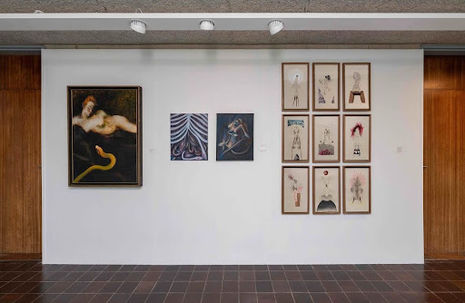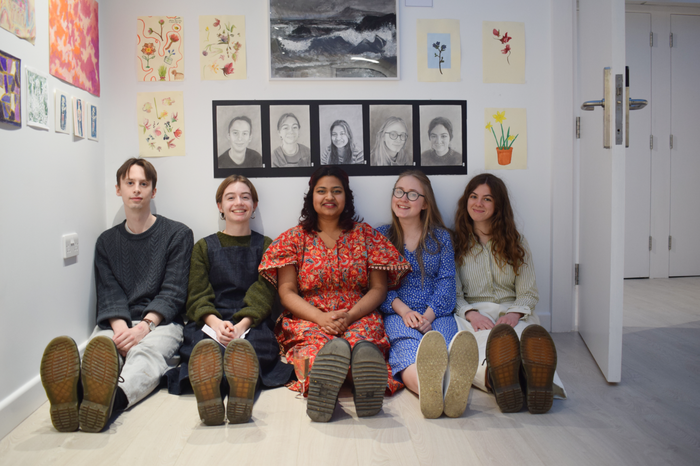Delving into ‘The Goddess, the Deity & the Cyborg’
Farrah Gowar reflects on Murray Edwards’ lastest exhibition which fuses the natural and supernatural

For centuries, divinity and womanhood have been intertwined in religion, literature, and art. Yet too often it veers into a harmful and unreachable expectation of perfection; a flattened, flawless symbol of divinity is preferred over the living and flawed. Murray Edwards’ new exhibition divides the image of ‘goddess’ into three sections, or the ‘trinity’, as described by curator Harriet Loffler: ‘the Goddess’ herself, ‘the Deity’ and ‘the Cyborg’. Using the traditionally Christian concept of the Trinity in the exploration of feminist goddess theory and representations of the non-binary ‘deity’ was an inspiration for the exhibition – and an important point of discussion in my conversation with Loffler. The exhibition shows fourteen artists re-conceptualising the image of ‘goddess’, transcending defined gender and form, and blurring together the past, present, and future, to create works that are both deeply introspective, while still speaking to the viewer.
“All the artworks were created while under the influence of one kind or another”
The idea of the ‘divine feminine’, or goddess Feminism, focuses on the worship of female deities to challenge patriarchal religious structures and celebrate paganistic beliefs. This non-conforming lens through which these artists explore womanhood has created truly boundary-pushing artworks, challenging external and internal perceptions of what ‘goddess’ means. All the artworks were created while under the influence of one kind or another, whether it was after taking hallucinogenic drugs or while under the divine influence of goddesses. Yet the dominant theme in the exhibition is hybridity: the cyborg. Loffler cites Donna Haraway’s essay ‘A Cyborg Manifesto’ as an influence for the exhibition, with Haraway’s description of the cyborg key to Loffler’s curation. The image of Mother Earth, the great natural goddess worshipped across religions, is at the exhibition’s centre – where usually the cyborg welds the human and the machine, the blending of the human with the natural persists throughout the works.
Serpentine imagery wraps around the exhibition, stretching through Hambling’s Hebe and her Serpent to McNamara’s Stirring Within and What They Hold. The image of woman and serpent prevails throughout, symbolising the connection between nature and ‘goddess’. But most powerful was Hambling’s decision to depict Hebe as naked. This not only references a prelapsarian Eve before the realisation of shame, but implicitly raises the issue of objectification and the invasion of the viewer’s gaze. The reclamation of objectification throughout the exhibition, particularly in Hambling’s work, was a captivating theme. A curvilinear mirroring between Hebe and the serpent creates an intimacy between the two, creating a sense of voyeuristic intrusion on the part of the viewer. ‘Goddess’ and nature thus appear one and the same.
“A curvilinear mirroring between Hebe and the serpent creates an intimacy between the two”
By including a range of backgrounds within the exhibition, Loffler emphasises the importance of blending cultures and ideas. This ensures the layered iconographies create a complex image of ‘goddess’ which transcends religious and mythological belief, with Hebe being Greek and the snake being a reference to the biblical Genesis. The focus on this interchangeability is enlightening, both in the exhibition and in conversation with Loffler. McNamara’s works also focalise the relationship between serpent and ‘goddess’, but instead create a physical fusion between the two. When speaking to her, Loffler highlighted McNamara’s inspirations: Aztec goddesses who were ‘degenerated for their sexual promiscuity’, with her work functioning as a reclamation of this denigration.
The study of the power of influence throughout the exhibition was done sensitively and delicately, through a range of lenses. From local Cambridgeshire, to Sweden to Nigeria, the breadth of artists and range of international influence found among only fourteen artists provides a widespread exploration of cultural influences.
With Mary Beth Edelson’s Goddess Head (2007) cited as the starting point for the show by Loffler, the spliced-together photography creates an interaction between the natural and the industrial. The relationship between the mechanical lens through which it is captured, and the artist’s own creative lens through which the figure is materialised, embodies the idea of the cyborg. Created under the influence of the great goddess and resembling early fertility statues, it marries the past with the present. It is the perfect opener for the exhibition, and one I often return to.
‘The Goddess, the Deity & the Cyborg’ runs from the 8th March- 8th September in The Women’s Art Collection at Murray Edwards College.
 News / Caius mourns its tree-mendous loss23 December 2025
News / Caius mourns its tree-mendous loss23 December 2025 Comment / Yes, I’m brown – but I have more important things to say22 December 2025
Comment / Yes, I’m brown – but I have more important things to say22 December 2025 News / Cambridge welcomes UK rejoining the Erasmus scheme20 December 2025
News / Cambridge welcomes UK rejoining the Erasmus scheme20 December 2025 News / CUP announces funding scheme for under-represented academics19 December 2025
News / CUP announces funding scheme for under-represented academics19 December 2025 Interviews / Politics, your own way: Tilly Middlehurst on speaking out21 December 2025
Interviews / Politics, your own way: Tilly Middlehurst on speaking out21 December 2025










